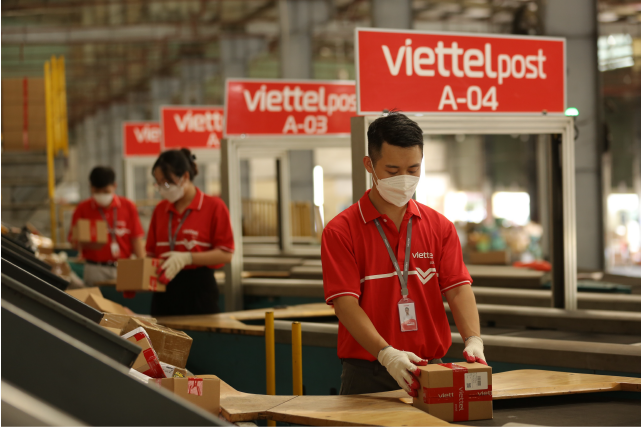Viettel Post dealing with obstacles and oppportunities
Nội Dung Chính
Viettel Post dealing with obstacles and oppportunities
Mr. Hoang Trung Thanh, General Director of Viettel Post, tells VET about the future of the CEP (Courier, Express and Parcel), logistics, and e-commerce market.

Mr. Hoang Trung Thanh, General Director of Viettel Post.
How would you assess Vietnam’s Courier, Express and Parcel (CEP), logistics, and e-commerce market at this point in time? What opportunities are there for Viettel Post?
CEP, logistics, and e-commerce go hand-in-hand, forming an inseparable field that is undergoing a period of very rapid development. This is a major opportunity for Viettel Post. The CEP sector is now estimated at nearly $5 billion, with annual growth of 30 per cent or more. Due to a number of global factors, however, the figure is somewhat lower at the moment but still hovering around 20 per cent. This figure also represents the fast pace of Vietnam’s domestic CEP market’s development.
Meanwhile, delivery costs in the e-commerce sector are estimated at up to $800 million. The value of other sectors such as cold storage has not been fully assessed as yet, but is certainly in the billions of dollars. Competition is extremely fierce, reflected in the number of licenses in CEP and e-commerce.
Can you be more specific in this regard?
Over the years, nearly 800 licenses to operate in Vietnam’s CEP market have been issued, including domestic and foreign enterprises, of which 50-70 are e-commerce platforms. Many foreign e-commerce giants with advantages in finance, technology, goods supply, and branding are present in the local market.
Meanwhile, China’s market has only eight major enterprises, all of which are domestic. The number of CEP businesses is also quite limited in many other countries, and they all operate under a licensing and competitive regulatory framework.
In Vietnam, competition in the field is so fierce that one can clearly see an annual fall in service prices. To compete against others, domestic CEP businesses usually rely on the formula of Profit = Revenue – Costs, while foreign-listed companies have their own game plan.
In particular, these foreign businesses only need to develop and expand the customer market in Vietnam and earn revenue to boost the stock price in their home country. With profits from rising stock value, they will continue to invest in the Vietnamese market. This reality reveals two completely different business environments. Companies that only use the profit equals revenue minus cost formula to compete will find themselves facing increasing difficulties.
By way of comparison, in the telecommunications sector, any operator who offers promotions violating the rules of self-management will be immediately forced to cease such action. However, in the CEP sector, for example, free delivery is considered an act of selling below cost. How can anyone compete with that? Small companies will be swallowed up by larger competitors.
Customers, of course, like to benefit from low prices. However, it is necessary to manage the competitiveness of the CEP industry, as it has become so fierce that service prices fall every year, to the point where nobody profits. This leads to a reality that can be seen by everyone, which is poor quality CEP services.
We lack strict and methodical management over prices, competitiveness, and service quality.
Large foreign corporations, with hundreds of billions of dollars listed on the exchange, can bring those billions to other markets to “burn” for 5-7 years or even a decade. Many giants doing business in Vietnam are losing money, but that’s okay because, as I said, the bigger the market and the more customers there are, the more their stock price will go up, resulting in more money to burn, even to the point of destroying all other businesses.
Therefore, the State must adopt price and competition management that is suitable for each field.
In short, there are still too many shortcomings in Vietnam’s CEP industry, from sector management to long-term issues such as national security.

Is it possible that losses incurred by Vietnamese CEP businesses are also due to internal issues?
Perhaps, but internal change requires strong resources. In their local markets or on a global scale, foreign businesses are very developed in terms of technology, finance, and management. Vietnamese businesses are not ready to make the changes needed to compete with these advantages once foreign businesses penetrate into Vietnam.
Given the current context, many domestic businesses will have to leave the game in just a little while. That being said, the big picture in the industry is rapid growth, huge opportunities, and poor competition. The nature of the competition reflects an incomplete legal framework on market management and a legal system that has not been updated, revised, or consolidated for a very long time.
We recently raised the issue of building the Postal Law, but during the law-making period we must still deal with inadequacies such as dumping, low quality workers, and a lack of service quality management, etc.
Can you tell us why Viettel Post was fortunately among the profitable units in 2022?
Firstly, Viettel Post’s revenue is still growing well. Secondly, we optimize costs by increasing workplace productivity and promoting digital transformation to save on paperwork and administrative costs. Digitized processes have saved a lot of money, even tens or hundreds of billions of VND. We also apply technology to prevent fraud during operations and the process of weighing merchandise. For example, we use IoT (Internet of Things) scales connected to the system, which helps us to optimize costs and improve efficiency and productivity.
What are the specific solutions Viettel Post will propose to maintain growth momentum amid fierce market competition and to create an advantage against the power of global corporations?
After much careful discussion, we have come to the conclusion that there are two solutions. The first is to optimize costs, and the second is to focus on services with high profit margins.
For example, with express delivery services, it normally takes three or four days or even five days to complete a shipping order. However, Viettel Post will build and design operating systems to be able to provide same day delivery or even within just a few hours. Customers are willing to pay up to 5-7 times more for such services, so profit margins in this service segment are also much higher.
Meanwhile, the B2B customer segmentation is a whole other matter. This group of customers only requires us to ensure good service quality, and they really don’t care about the benefit of a several thousand VND discount. Customers are willing to pay a little more for a better shipping service. Similarly, we can charge a higher price for the delivery of agricultural products and fresh goods.
Regarding e-commerce, when positioning ourself as a regular e-commerce platform, Viettel Post may face competition with the “big names” in the market, like Shopee, TikTok, and Lazada. At that time, we will have to deal with issues such as finance, technology, supply sources, and branding. Viettel Post could also only focus on agricultural products, which are special goods with a lifetime of only hours or days. In this case, however, building a trading platform for buyers and sellers is not enough. It is crucial to have accompanying infrastructure to preserve products from the place of production to the place of consumption.
Viettel Post has been identified as one of four main pillars in the development strategy of the Viettel Group, including domestic and foreign telecommunications; digital payment and solutions; high-tech production research; and trade and logistics. What are your thoughts on being a so-called “main pillar” of the Group?
Setting goals for Viettel Post determines the growth direction in the time to come. We are enjoying annual growth of 30 per cent, and if we do a good job, this could grow to 50 per cent and within five years revenue could be ten-fold higher than today. In my opinion, viewing Viettel Post as a “main pillar” of the Viettel Group is absolutely appropriate. The question is how to achieve the targets.
Does annual growth of 50 per cent seem overly ambitious?
Some 17 or 18 years ago, Viettel began its journey as a telecommunications company. At that time, there were years when the corporation recorded annual growth of 200-300 per cent. Viettel Post may not be able to approach 50 per cent growth over the next year, but this is certainly achievable if it can follow defined strategies in a timely manner.
After many years of struggle, the Viettel Group has risen to the No. 1 position in Vietnam’s telecommunications industry. Some of its member units have also become leaders or aim to take the leading position in their business field. What do you think about Viettel Post reaching No. 1?
Every company and every businessperson aspires to become Number 1 in their field. Viettel Post is not yet Number 1 in Vietnam’s CEP industry, and I personally have never said anything about the company’s determination to become Number 1. We just want to focus our minds and do our job well. We have faith in ourselves, just like the Viettel Group did 17-18 years ago when standing in front of a historical moment that changed Vietnam’s telecommunications sector. At this very moment, I believe that Viettel Post is also seeing a historic opportunity to change Vietnam’s logistics sector.






